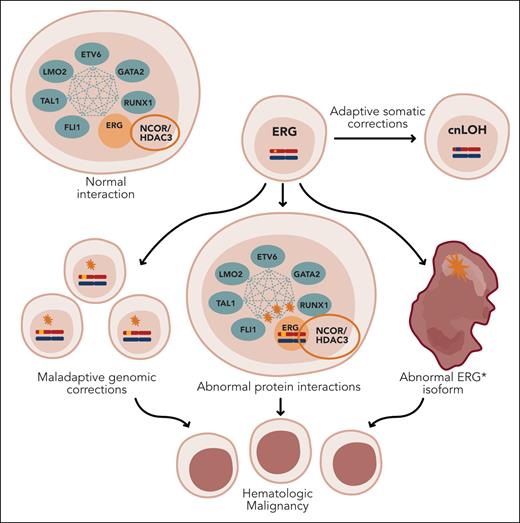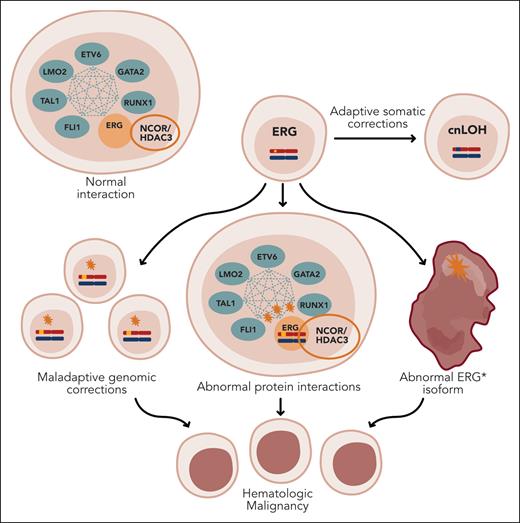In this issue of Blood, Zerella et al1 report an autosomal dominant syndrome of bone marrow failure (BMF) and predisposition to hematological malignancies (HMs) caused by heterozygous loss-of-function mutations in ERG (ETS-related gene). As ERG is known to be a hematopoietic oncogene, the increased risk for HM is surprising and suggests that ERG may be both an oncogene and a tumor suppressor.
ERG encodes a pointed domain ETS transcription factor (TF). Its “good side” is that it is required for hematopoietic development, hematopoietic stem cell self-renewal, and the normal development and differentiation of megakaryocytes and B cells.2,3 It functions as a part of a small orchestra of a heptad of TFs that include RUNX1, ETV6, GATA2, FLI-1, LMO2, and TAL1. The first 3 are known to be hematopoietic tumor suppressors, and the last 3 are hematopoietic oncogenes. Interestingly, GATA2, like the newly discovered role of ERG, is both an HM oncogene and suppressor.
ERG can be “bad”; it is a known oncogene. ERG drives more than half of prostate cancers by misexpression caused by a chromosomal translocation, and it is also translocated in a minority of Ewing sarcomas. About half of all acute myeloid leukemias are ERG dependent.4 It is often recruited to hematopoietic oncogenic protein complexes and is required for their oncogenic activity.5
Given the role of ERG in hematopoietic development, the discovery of the “ugly” part of ERG, as mutated in BMF syndrome, was expected. Indeed, it was preceded by a similar discovery in a mouse model.6 The mutations in both humans and mice are loss-of-function mostly in the ETS DNA binding and protein interaction domain. Although the mutated protein fails to transform mouse fetal liver hematopoietic progenitors, in humans, surprisingly, there is a substantial risk (>30%) to develop hematopoietic malignancy by the age of 40. Interestingly, the mouse model displayed BMF only without HMs.
Presently, the mechanisms by which a haploinsufficiency of a known hematopoietic oncogene causes HMs are unknown. There are at least 3 potential hypotheses (see figure).
Hypotheses for maladaptive mechanisms for ERG haploinsufficiency resulting in HMs. This figure illustrates the normal interactions of ERG as part of a heptad of TFs. Although ERG mutation can result in an adaptive somatic corrections (cnLOH), several suggested scenarios may lead to malignancy: maladaptive genomic corrections, abnormal interactions with other TFs, and the expression of aberrant ERG isoforms. Professional illustration by Somersault18:24.
Hypotheses for maladaptive mechanisms for ERG haploinsufficiency resulting in HMs. This figure illustrates the normal interactions of ERG as part of a heptad of TFs. Although ERG mutation can result in an adaptive somatic corrections (cnLOH), several suggested scenarios may lead to malignancy: maladaptive genomic corrections, abnormal interactions with other TFs, and the expression of aberrant ERG isoforms. Professional illustration by Somersault18:24.
The first is common to all BMF syndromes. The growth defects induce pressure for growth of clones that underwent genomic adaptation. Indeed, in several patients described by the authors, copy number-neutral loss of heterozygosity led to correction of the ERG haploinsufficiency and, consequently, correction of the BMF. This correction also directly proves the functional role of ERG haploinsufficiency in the syndrome. Yet genomic corrections can often be maladaptive. Growth-promoting mutations in other genes may cause expansion of hematopoietic clones and cause HM. Indeed, in 1 of the patients, still with BMF without HM, the authors discovered a subclone with pathogenic RUNX1 mutation. This clone may eventually evolve into HM.
The second potential mechanism is an indirect HM-promoting effect of the mutated ERG. Interestingly, all the pathogenic or likely pathogenic mutations were point mutations in or at the vicinity of the ETS domain, thus retaining the amino terminal part of ERG. The mutated protein was expressed. Similar somatic mutations were noted by the authors in the Catalogue of Somatic Mutations in Cancer (COSMIC) database, suggesting a potential active role of mutated ERG in cancer. It is possible that the interaction between the mutated ERG with other “heptad” hematopoietic TFs could contribute to development of HM.7 We discovered that ERG interaction (through proline #199) with the NCOR/HDAC3 repressor complex is necessary for its leukemogenic activity.8 Almost all mutated ERG described in the current publication retain this interaction.
The third hypothesis is that the mutations result in aberrant expression of an abnormal ERG isoform. Indeed, in DUX4-driven acute lymphoblastic leukemia, a novel isoform of ERG is believed to drive the leukemia.9 Similarly, RUNX1, a known tumor suppressor, was shown to initiate leukemia through an expression of an oncogenic isoform.10
These and other questions raised by the exciting discovery of the Australian and the international consortium open the stage to significant and exciting research.
Conflict-of-interest disclosure: The authors declare no competing financial interests.



